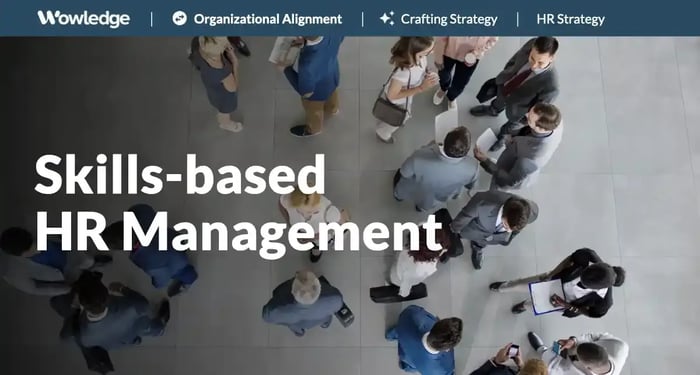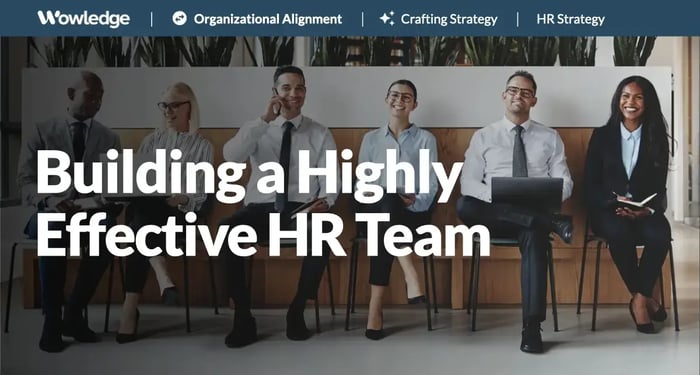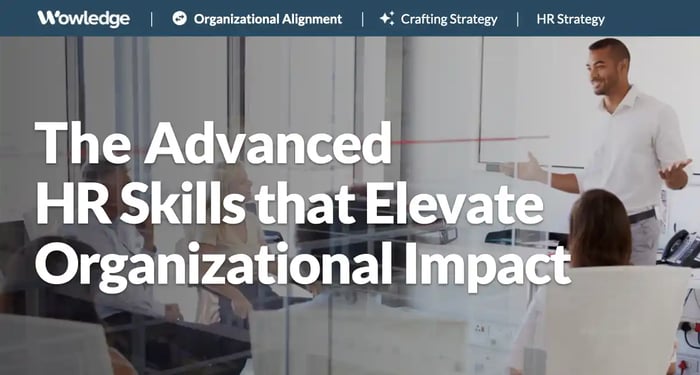Table of Contents
As organizations battle high turnover and tight labor markets, leaders continue to search for better ways to both understand and manage talent requirements. While looking at ever-expanding lists of open requisitions and employee resignations, the question of how to keep up with the pace of replacements of mostly full-time human assets swirls around the discussions. The answer lies in part in the use of skills-based HR.
An intriguing answer has cropped up over the past few years that is calling for a view of staffing requirements not through the lens of employees in roles, but rather as individuals with unique combinations of skills. It is skills after all, that allow people to accomplish tasks, complete job requirements, deliver value, and contribute to project or initiative success.
Skills are defined as “the ability to use one’s knowledge effectively and readily in execution or performance” (Merriam-Webster), and as such are becoming the new currency of HR and talent processes and programs. They are, in this context, used to define the human requirements necessary to perform tasks and work to be accomplished. And their use as the lingua franca of HR management offers the possibilities for greater clarity, staffing flexibility, fairness, and widened opportunities for workers regardless of educational and socio-economic status.
The challenges demanding skills-based talent
Recent research has made interesting observations that support the use of skills as the basis for employee selection, development, promotion, and mobility. Deloitte reports that 63% of executives say their employees are working on tasks outside of their normal duties as defined in job descriptions. McKinsey’s research revealed that hiring for skills is five (5) times more predictive than education for job performance, and two (2) times more effective than hiring based upon work experience. Furthermore, LinkedIn states that non-degreed employees (presumably selected based on skills) stay 34% longer with their companies than their degreed counterparts.
The World Economic Forum reported that due to the speed and volume of advances in technology, 50% of workers globally will need to reskill every couple of years, and that associated “job destruction” is accelerating at a faster rate than job creation. It is estimated that 97 million new jobs will emerge as work shifts towards a balance between humans, machines, and algorithms (read: artificial intelligence). Adding to this is a recognition by corporate leaders that they will need to reskill 50% of their workers if they want to avoid layoffs.
All these findings point directly to an urgent need for organizations to understand the “pieces” of human capability, such that they can more accurately assess their capabilities, the likely impacts of planned technology adoption, and the development needs of their workers.

The big shift towards skills management
The use of skills represents a movement away from the definition of job requirements as fuzzy constructs such as broad education and experience minimums. It means that the worker is valued and evaluated based upon what they can do versus what role or level they occupy. For example, who knows what an individual learned or can apply from four years of college or whether 12 years of experience is really the right type and amount to enable success in each role in another company? How much certainty can one place on whether providing customer service in a retail environment will transfer to customer support in technology?
What this movement relies on is the idea that greater granularity in job requirements can focus more fairly and equitably on the skills one has acquired and refined over a period of time. At the same time, it will enable a more accurate view of the aggregated human capabilities needed and in place relative to the business goals and objectives it is pursuing.
The shift itself is a deconstruction of traditional jobs or roles into their component tasks based upon the outcomes they are designed to accomplish. It calls for the replacement of old-school job requirements (education and experience) with skills that are directly attached to the major tasks and outcomes expected from a given job.
The output of such an effort is often a fractionalizing of a series of jobs into work segments that can either be parsed out to part-time assets (e.g., contractors, gig workers) automated, or reformed into a series of new internal roles. Core to this is the value proposition that jobs can be redefined and reformed based upon either the use of a common or related set of skills, performance in a common set of circumstances, and/or the desired outcomes. Outcome-based job design is a bit of a holy grail that might see the light of day in the coming years. For example, imagine a job that is defined by accurate and effective patient diagnosis, intervention, healing and comfort or wellness—for physicians and nurses. The skills that would be used as criteria for selection and performance management would exclude many of the administrative duties that they currently are required to perform.
Ideal prerequisites of a skills-based organization
A prototypical scenario for making the shift towards a skills-based HR involves both a change management strategy and talent management process integration that will create an appetite for the change, and a supportive infrastructure. Whether or not these exist at the outset of making the shift, addressing them and taking steps to create and incorporate them into the culture will help drive success. Industries that operate on a primarily project basis (construction, consulting, accounting, engineering, etc.) can offer a window into the elements of success, but even for those to create a reliance on skills-based management, primary keys to movement include:
• A culture of continuous learning, where skill acquisition and growth are considered a critical and regular part of the employee experience and employment brands.
• An agile workforce that is used to taking on challenging assignments and projects as part of their normal workloads.
• Expectations and experience with mobility within and across the organization, such that changes in job duties are not a foreign concept.
• Managers viewing talent as shared corporate resources to avoid talent hoarding and immobility.
• Access to an appropriate range of skill learning and development resources and activities.
• Top leadership awareness and support.

Making the shift to skills-based HR
Making the move towards skills-based HR requires a series of actions that will create an infrastructure and processes that are used to drive the adoption of skills as the basis for the definition of task and job requirements, learning and career development, staffing methodologies, and job or promotion candidacy criteria. Steps to consider include:
1. Identify (or create) a skills catalog
There are several ways to accomplish the development of a catalog of skills. Referred to as skills “taxonomy”, “inventory” or “ontology”, these are a comprehensive listing of all the skills that employees in a company and industry might leverage while performing their tasks or projects. They cover what are known as both technical (diagnosing, coding) and soft (collaboration, communications). Such catalogs can be purchased on a stand-alone basis, or as integrated into a talent/HR/learning system, and often are organized into skills clusters that make it easier to find suitable skills, especially as they evolve and are refined across use cases.
Lacking the resources for acquiring such a database, the creation of one can be accomplished through a review of job descriptions (by job family) with a specific skill called out for each of the key job requirements. It is recommended that such an effort starts with the highest priority roles, such as those identified in a critical workforce segmentation exercise.
2. Reconstruct job descriptions
Formal job descriptions should be rewritten to focus on primary tasks, outcomes, and the related skills that will be applied to satisfactorily perform and achieve those. The job requirements should be cleared of any reference to education (except if required by law or regulation, such as with doctors or lawyers), years of total or industry experience, with those replaced by specific skills and experience applications (e.g., leading teams in a structured project management environment), and specific certifications that communicate and confirm skill acquisition, etc.
Reconstructed job descriptions can then be leveraged to create new job postings for use when assessing internal candidates for transfers or promotions, recruiting new employees as additions or replacements, and identifying suitable contractors for a project or short-term work. One advantage to this approach is the opening of broader talent pools and a resulting larger number of suitable applicants for each role.
3. Assess employee skill levels
Several ways to accomplish skill level assessments are available using technology, either through an existing talent/HR/learning system or through an employee survey. In either case, the employees are presented with the full catalog of skills, and they are asked to a) identify the skill they purport to have, and b) the level of competence. Then such skill assessments may be reviewed by a direct manager to validate, edit and/or add skills to the assessment. Further use of skills testing at the end of learning programs, “boot camps”, and/or certification programs can offer a more formal and objective means of validating skill acquisition and competency levels.
Those assessments can then be aggregated for an organization-level view of the capabilities and shortcomings of the workforce and its critical segments. This can be used to conduct a buy-build-borrow assessment related to where the required skills will be sourced.
4. Integrate skills into talent and HR processes
A priority should be given to integrating skills with the learning and development ecosystem for the ready identification and assignment of courseware to specific skill acquisition targeting. Classes, eLearning, reading, free online learning, books/articles, podcasts, certification programs, and the like should be indexed through the learning management (or related) system to direct employees’ efforts on this front. Additional development can be effective in further developing skills through job rotations, temporary assignments, mentoring, and special projects, among other experiential development opportunities.
The second priority should be given to targeting employee groups for development, such as with metrics and reporting team members being assigned data science learning programs, software engineers talking programs related to AI or machine learning skills, etc. Such development should be focused upon the skill and capability gaps associated with the company’s most critical future business growth and development initiatives.
Reviewing of compensation benchmarking and leveling practices for these newly skills-defined roles is essential to make sense of the relative (and evolving) value of different jobs across the enterprise. And creating reward and recognition programs for skill attainment (ideally through testing and certification processes) will serve as an integrated incentive system for continual learning. Statistical testing can assist with predicting the value of each skill or skill cluster, and leading-edge companies (e.g., IBM) are starting to experiment with AI to determine pay based upon various aspects, such as market and internal demand and skills scarcity.
A skill-based review of leadership roles and their requirements is an essential element to make sure that as those roles evolve, the right leaders are being both identified for and through the succession management process and trained and developed via the leadership development programs.
Advantages of skills-based management
The leveraging of a skills-based management ecosystem will enable greater clarity of requirements, more efficient use of resources, and a more robust analysis of an organization’s talent strengths and weaknesses. Other advantages include:
• Common language and framework for talent discussions and decisions.
• Earlier recognition of new and emerging skills or skill clusters.
• Improved view of talent pools and the depth and breadth of related capabilities.
• Better direction for identifying employee career development options and pathways.
• Increased accuracy and direction for targeting learning and development options.
• More rapid identification of skills gaps and blind spots.
• Improved ability to pivot and reallocate employees.
• More accurate candidate assessment.
• Improved detail and specificity of workforce planning.
• Reduced bias in candidate screening and selection.
• Simplified distribution of workloads and people to teams.
Perhaps most importantly, by eliminating broad educational requirements and relying instead on the skills needed for job performance, the roughly 52% of U.S. workers who lack an associate or bachelor’s degree can make a sizeable addition to the available workforce if their skills and/or certifications match the needs of the organization.

Implications and considerations
A number of considerations must be taken into account when planning out such a shift. As the changes will take time to take hold and evolve over time, it is critical to understand that the creation of a skills inventory is not a one-time action. Maintaining the currency of the database is essential, as the expectation should be established that as new skills emerge, others will become obsolete with the continuing adoption of technologies and shifts in business strategies. A governance model therefore should be adopted for accepting and tracking the use of any new skills that emerge (or are suggested). In this way, the various HR teams can be kept in the loop to ensure that linkages are created between new skills and compensation (valuation) decisions, additions and updates can be made to learning programs, and changes to job descriptions and postings can be communicated.
Just as skills will emerge in the database, the acquisition of new skills should be recorded by employees and their managers through periodic updates to the employee skills record. This can be accomplished at a minimum through an annual review in concert with the performance evaluation process, where employees both add newly acquired skills and update the level of competence for all skills over the prior year. Including this as a required activity in the performance management or career development cycles will drive a more accurate reporting of skills for workforce planning, employee mobility, and career development purposes.
Another consideration is the collection of not only skills but data related to employee interests and ambitions as well. By gathering such data as part of the performance or career development processes, employee goals may be better discussed and planned for. Two details are critical drivers of this: 1) employees may have skills that they are less interested in applying going forward (e.g., due to burnout or a desire for change), and 2) interests and ambitions may help identify “hidden gems” for future leadership or critical skill roles. Both of these can also serve as a driver of employee retention, as their career interests, when acted upon, can lead to longer tenure, engagement, and satisfaction with their work and role within the company.
Contemplate the need for new or enhanced policies regarding the continued employment of employees whose skills lapse or are rendered obsolete with changes in how the work is accomplished. With the projection of increasingly fractionalized work and more agile staffing methodologies, it is foreseeable that some employees will only have partial sets of skills needed for the work to be accomplished. Policies will be needed to account for reskilling time, developmental assignments to develop missing skills needed to perform the work, time for training and certifications, general “bench” time between assignments, losses of efficiency, and whether an employee is able to maintain a minimum of 40 hours full time or not. General redeployment policies should be planned and created to handle the inevitable challenges that will arise from quickly evolving skill requirements.
Be prepared
Keeping up with the myriad of changes that come along with a shift towards skills-based HR will be a challenge, but the benefits can outweigh the work associated with creating the necessary ecosystem. One major step is to investigate talent marketplace technologies, that combine skills inventories, job postings and skills requirements, and employee profiles. While these are newer to the HR technology scene, they are reported as showing great promise to simplify processes related to project and team staffing, needs identification, employee mobility, and skill cataloging and tracking. Those are essential applications of skills-based HR, and hold the promise of supporting greater accuracy and insights into employee capabilities across functions, business units, and locations.
Consideration of making the shift is also an opportunity to think about and plan for the implications of new technologies on roles, tasks, and the possible future mix of people vs. machine work. The movement towards a world where people’s work will be increasingly interactive with machines, software and algorithms is starting to feel like an inevitable and current climb towards the future (see Building an AI-Native Workforce, for example). Understanding how it can impact work and people, and how to best measure it through a more refined look at how work gets done through the lens of applied skills is a great starting point.
Relevant Practices & Tools
Advanced HR Strategy Practices to Plan for Delivery of Impactful HR Services and Support. >
Advanced HR Strategy is a refined approach to planning long-term HR priorities. It involves increased specificity of plans and goals around key employee groupings and uses detailed workforce data and projections to clarify the needs and trends impacting those groups... more »
Defining Capabilities, Tasks, and Roles to Create Clarity and Accountability in the Organization. >
A well-functioning organization provides clarity regarding the work required to achieve its objectives. It also provides a shared understanding of who will perform that work... more »
Establishing a Robust Methodology for Job Descriptions and Evaluations Across the Organization. >
Job descriptions and evaluations are critical components to defining any compensation strategy. While job descriptions can be found on a significant variety of templates, each document must provide the required level of detail to understand the expected contributions and requirements for each job... more »
Structuring the HR Organization to Best Meet Business Needs. >
The design of an HR organizational model requires considering a number of potential factors—the available HR budget, business organizational structure, business and HR strategic plans, critical workforce segments, and the company's culture... more »
The Skills Taxonomy Tool: Define and Organize Job-relevant Skills Used in Different Jobs Across a Company. >
A tool to categorize and define the abilities needed to perform jobs across the enterprise. It is a catalog that can be used in collecting and assessing the individual and aggregate availability of skills required to perform different jobs in the organization... more »
FAQs
How should HR define a practical skills taxonomy without overcomplicating it?
A workable taxonomy starts with priority roles, breaks them into core tasks and the skills required to perform them, and uses plain language and consistent levels. Clustering related skills under families keeps navigation simple and supports reuse across jobs. Version control, owners for each cluster, and a lightweight change log prevent bloat while allowing updates as work evolves. Using skills databases or taxonomies from Cloud-based open-source or HR system providers can ease the burden of updates.
What metrics show the ROI of skills-based HR in the first year?
Early indicators include reduced time-to-fill for priority roles, higher qualified applicant rates, and increased internal moves into skills-matched opportunities. Quality of hire improves when first-year performance and retention rise for skills-hired cohorts. On the cost side, fewer external hires for scarce roles and better learning alignment lower the spend per capability gained.
How can HR validate employee self-reported skills reliably?
Self-declarations should be paired with manager review, brief practical assessments, or evidence artifacts such as bona fide certifications, work and project outcomes, and academic or professional credentials. Spot checks and periodic revalidation prevent inflation and keep proficiency levels realistic. Calibration sessions across teams establish a common standard for what “proficient” means in the organization’s context.
How should policies handle employees with obsolete or partial skills while maintaining fairness?
Policies should define reskilling pathways, time allowances, and the criteria for placement on projects that build missing skills. Transparent rules for “bench” (idle or non-productive) time, certification targets, and job reassignment reduce uncertainty and protect pay during transitions. When redeployment is not feasible, separation decisions should be based on documented skill requirements and offered development options.










